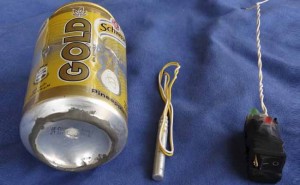 #NewYark/#Russia : How could a soda can bring down a passenger jet? The Islamic State circulated a picture of what it said was an improvised explosive device used to blow up a Russian passenger plane over the Sinai Peninsula last month, killing all 224 people on board. As photographed, the device is designed to masquerade as a common beverage can.
#NewYark/#Russia : How could a soda can bring down a passenger jet? The Islamic State circulated a picture of what it said was an improvised explosive device used to blow up a Russian passenger plane over the Sinai Peninsula last month, killing all 224 people on board. As photographed, the device is designed to masquerade as a common beverage can.
The New York Times asked career bomb-disposal technicians for their first impressions of the pictured device, with the understanding that the photograph is of marginal quality and not all the components can be clearly seen.
The answers were consistent: The device depicted is nothing new or surprising, and it would not be hard for an experienced bomb maker to build.
The component, with black tape and a manual switch, could serve one of a number of functions. Many bombs have an arming-safe switch, and a separate mechanism for initiating the blasting cap and setting off the explosion.
The wires seen are probably electrical connections for the blasting cap. The rest of the circuit, hidden under the black tape, could include small batteries and the electronics needed to send a charge to the blasting cap at the intended moment. The cap would then detonate a main explosive charge in the aluminum can.
The can has a hole in the bottom and shows signs of being filled with explosive paste. It is not likely to be a liquid bomb; that might require the black-taped component to be waterproof (it does not appear so) or rigged outside the can (which would make the soft-drink ruse more vulnerable to detection). The bottom seems crudely resealed and may expose a white substance, indicating that the contents are more likely solid.
A thorough technical analysis is impossible from the image, but one disposal technician said a soda can could be packed tightly with enough high explosive to seriously damage a jetliner. Although the blast would probably not destroy the plane outright, depending on the nature and location of the damage, it could start a catastrophic sequence of events. A jet moving at cruising speed could then shear apart and break up.
The can has room for more explosive than normally found in a standard military hand grenade, and two jets that crashed in Russia in 2004 were reported to have been brought down by grenades.
A device like this, placed on a passenger plane, could be detonated by a timer, by a remote-control signal from someone on the aircraft, or by other means.
One disposal technician said that if the device were a radio-activated bomb, it might explain the relatively long wire in the photo: It might serve as an antenna. But after closer examination of the image, he said the wire probably just connected the blasting cap to a power source.
Technical matters aside, it would be simpler operationally to detonate a bomb like this with a timer, because that would not require getting both the bomb and the bomber on board the plane.
Another bomb disposal technician said that the bomb itself was not impressive, but that the photograph of it was taken cannily: With the key components covered with black tape, “you can’t tell what it is under there, or what it isn’t.” He said many small, simple low-power timer designs could fit under the tape, including one commonly used in Palestinian bomb making.
He said the device looked much less sophisticated than the remote-controlled bombs that have repeatedly been seen in Afghanistan and Iraq, which include features to defeat jamming and other countermeasures.
The photograph alone does not establish that the Islamic State accomplished any of this. It may be an example of the group’s adeptness at gaining attention, not an indication of its activities : The New York Times News Service
Leave a Reply